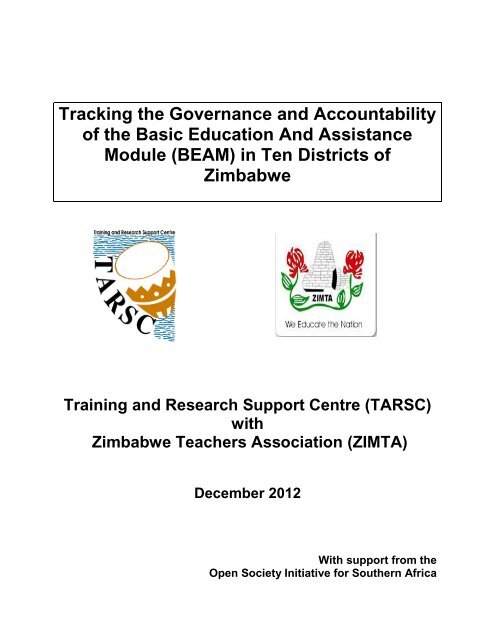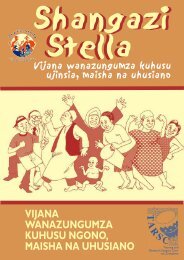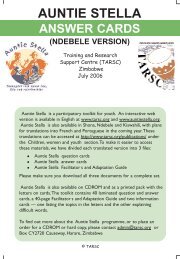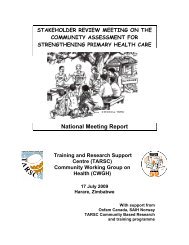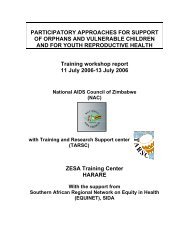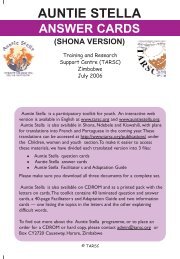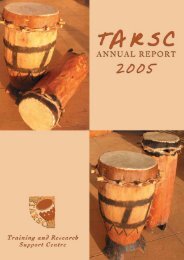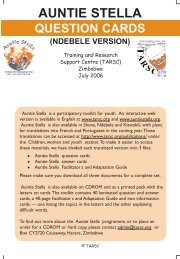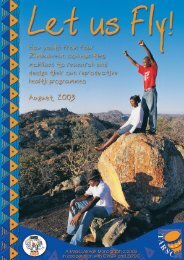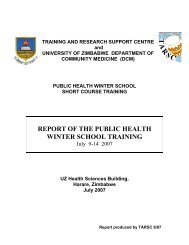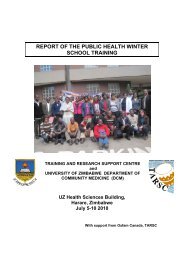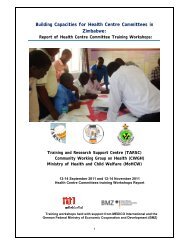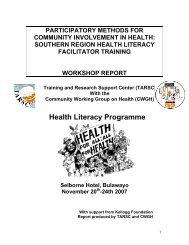BEAM rep final.pdf - Training and Research Support Centre
BEAM rep final.pdf - Training and Research Support Centre
BEAM rep final.pdf - Training and Research Support Centre
Create successful ePaper yourself
Turn your PDF publications into a flip-book with our unique Google optimized e-Paper software.
Tracking the Governance <strong>and</strong> Accountability<br />
of the Basic Education And Assistance<br />
Module (<strong>BEAM</strong>) in Ten Districts of<br />
Zimbabwe<br />
<strong>Training</strong> <strong>and</strong> <strong>Research</strong> <strong>Support</strong> <strong>Centre</strong> (TARSC)<br />
with<br />
Zimbabwe Teachers Association (ZIMTA)<br />
December 2012<br />
With support from the<br />
Open Society Initiative for Southern Africa
Table of Contents<br />
Executive Summary ................................................................................................................................... 2<br />
1. Background <strong>and</strong> rationale ................................................................................................................. 5<br />
1.1 The budget Process <strong>and</strong> Actors ................................................................................................ 6<br />
1.2 <strong>BEAM</strong> Programme ...................................................................................................................... 6<br />
1.3 Institutional arrangement of the <strong>BEAM</strong> .................................................................................... 9<br />
1.4 Stakeholder Mapping for <strong>BEAM</strong> .............................................................................................. 10<br />
1.5 The Pilot Survey ........................................................................................................................ 11<br />
2. Aims of the Assessment .................................................................................................................. 12<br />
3. Methods ............................................................................................................................................. 12<br />
4. Findings ............................................................................................................................................. 14<br />
3.1 Governance of <strong>BEAM</strong> Funds ................................................................................................... 15<br />
3.2 Accountability for <strong>BEAM</strong> Funds ............................................................................................... 16<br />
3.3 Beneficiaries Views of <strong>BEAM</strong> Programme ............................................................................ 17<br />
3.4 Selection Committee, Accountability <strong>and</strong> Governance Issues ........................................... 18<br />
3.5 Summary of Key informant views on <strong>BEAM</strong> ......................................................................... 19<br />
5. Discussion ......................................................................................................................................... 20<br />
6. Recommendations ........................................................................................................................... 21<br />
7. References ........................................................................................................................................ 23<br />
7.1 Abbreviations .................................................................................................................................. 23<br />
Cite this publication as: <strong>Training</strong> <strong>and</strong> <strong>Research</strong> <strong>Support</strong> <strong>Centre</strong> (TARSC), Zimbabwe Teachers<br />
Association ZIMTA (2012) Tracking the Governance <strong>and</strong> Accountability of the Basic Education<br />
Assistance Module (<strong>BEAM</strong>) in ten districts of Zimbabwe TARSC Harare.<br />
Acknowledgements:<br />
We acknowledge with thanks the Ministry of Labour <strong>and</strong> Social Welfare for the input to the study<br />
questions, the Community Monitoring Coordinating Committee (CMCC) for the input to the protocol <strong>and</strong><br />
The Ministry of Education Sport <strong>and</strong> Culture for permission to interview School Authorities.<br />
1
Executive Summary<br />
The Basic Education Assistance Module (<strong>BEAM</strong>) is one of the important pro-poor funds that are<br />
meant for the marginalised <strong>and</strong> vulnerable communities in Zimbabwe. <strong>BEAM</strong> is a programme<br />
that provides school fees, examination fees, levies <strong>and</strong> building assistance. It was introduced by<br />
the Government of Zimbabwe in 2001. It targets the vulnerable children who are unable to pay<br />
school fees or those who fail to go to school as a result of non-availability of money. According<br />
to a 2012 <strong>BEAM</strong> evaluation <strong>rep</strong>ort, of the estimated 3.6 million children of school going age<br />
(primary <strong>and</strong> secondary) in Zimbabwe, approximately 1 million of them are in need of financial<br />
assistance. Out of the 2.8 million primary school going children an estimated 28% of them are in<br />
need of fund assistance. However, only 16% are received the funds in the previous year. For<br />
secondary schools pupils the <strong>rep</strong>ort notes that about 24% children needed assistance with only<br />
17% receiving the assistance.<br />
Apart from inadequate funds to pay for those in need, there are a number of fund management,<br />
accounting <strong>and</strong> governance issues that have affected the programme since its inception. Prior<br />
to this work the <strong>Training</strong> <strong>and</strong> <strong>Research</strong> <strong>Support</strong> <strong>Centre</strong> (TARSC) carried out a pilot survey on<br />
<strong>BEAM</strong> <strong>and</strong> identified a number of issues affecting its operations that require closer monitoring<br />
<strong>and</strong> evaluation of the schools on the use of funds by their parent ministry, the funding ministry<br />
(Ministry of Labour <strong>and</strong> Social Welfare) <strong>and</strong> other funding agencies. The pilot survey noted that<br />
selection of beneficiaries was cumbersome <strong>and</strong> prone to manipulation. The administration of the<br />
programme was perceived as not transparent in some schools.<br />
To assess some of these operational challenges <strong>and</strong> offer some suggestions to improve the<br />
administration of <strong>BEAM</strong>, TARSC in association with Zimbabwe Teachers Association (ZIMTA)<br />
carried out a survey to assess the general underst<strong>and</strong>ing of the <strong>BEAM</strong> programme by those<br />
who are executing it <strong>and</strong> benefiting from it at the local district level.<br />
A cross sectional survey was implemented in 10 districts selected on the basis of vulnerability<br />
from nine out of the ten provinces of Zimbabwe. The survey obtained information from 200 key<br />
informants (school Heads, bursars <strong>and</strong> accounts clerks), <strong>and</strong> 189 beneficiaries through<br />
structured interviews. It assessed the availability <strong>and</strong> use of <strong>BEAM</strong> guidelines in schools, the<br />
criteria for selection of beneficiaries <strong>and</strong> the underst<strong>and</strong>ing of the selection guidelines by the<br />
school authorities <strong>and</strong> selection committees, the accounting <strong>and</strong> auditing of the <strong>BEAM</strong> funds<br />
<strong>and</strong> the organs that carry out the auditing, the frequency of those audits <strong>and</strong> the disbursements<br />
<strong>and</strong> absorption of funds by the Ministry of Finance <strong>and</strong> schools respectively. ZIMTA provided all<br />
the research assistants that were used in the survey drawn from all the nine participating<br />
districts of Zimbabwe. TARSC provided the technical inputs, training, analysis <strong>and</strong> <strong>rep</strong>orting.<br />
The Open Society Initiative for Southern Africa (OSISA) provided the funding for the survey..<br />
The research assistants from ZIMTA were trained for a day on how to administer the key<br />
informant <strong>and</strong> beneficiary questionnaires.<br />
Results from the survey showed that <strong>BEAM</strong> support was valued by beneficiaries <strong>and</strong> schools.<br />
The funds allocated to the <strong>BEAM</strong> programme were however found to be inadequate relative to<br />
need. Of the 15 243 potential beneficiaries in the participating schools’ registers, only 8533<br />
(56%) were receiving <strong>BEAM</strong> assistance as a result of inadequate funds.<br />
Faced with a large number of potential beneficiaries versus limited resources, there were issues<br />
of non coverage of people in need <strong>and</strong> issues raised on funds were allocated to those who did<br />
receive. About a third (38.1%) of community elders interviewed observed that schools did not<br />
display a list of the <strong>BEAM</strong> beneficiaries on the public notice board. The public display of names<br />
2
as seen to be a way the community could verify those who had benefitted to ensure<br />
transparency <strong>and</strong> fairness in the selection of beneficiaries.<br />
The auditing of the <strong>BEAM</strong> funds remained a challenge in most of the schools surveyed, with the<br />
ministry having given up that role to the school development committees <strong>and</strong> other independent<br />
monitors. This made it difficult for the MoLSW to properly monitor the use of these funds. It is<br />
important to note that 93% of the schools surveyed included <strong>BEAM</strong> funds with other funds in the<br />
school’s general account, posing challenges when accounting specfically for the <strong>BEAM</strong> funds.<br />
Most of the schools surveyed (65%) <strong>rep</strong>orted not having any or not being aware of manuals that<br />
gave directions on how the <strong>BEAM</strong> funds could be accounted for, including the rules for the fund<br />
management.<br />
The <strong>BEAM</strong> programme experienced late disbursement of funds that compounded the financial<br />
problems of schools that had greater numbers of their pupils on the benefit. As a result of the<br />
late disbursement of these funds; there were cases of schools remaining with unused funds at<br />
the end of the year, either because the guardians (72.4% of guardians in this survey) of the<br />
beneficiaries would have used their own money to pay for fees <strong>and</strong> levies, or the beneficiaries<br />
would have dropped out of school completely. In cases where guardians would have used their<br />
own funds, there were no cases of schools reimbursing the guardians their money, even though<br />
this may have been obtained through loans or impoverishing sales of assets.<br />
In order to address some of the operational problems such as accountability <strong>and</strong> good<br />
governance of the of the <strong>BEAM</strong> programme at the local level, key informants proposed that;<br />
On Governance <strong>and</strong> Financial Accountability<br />
It needs to be made clear who audits the <strong>BEAM</strong> funds. Some schools <strong>rep</strong>orted that their<br />
finance committees did the auditing, while others <strong>rep</strong>orted school deputies <strong>and</strong> senior<br />
teachers, while others <strong>rep</strong>orted the Ministry of Labour <strong>and</strong> Social Welfare did the audit.<br />
Council schools’ accounts were audited by their respective local authorities, while Farm<br />
Estate schools were audited by private auditors. Most of the audit <strong>rep</strong>orts produced were<br />
not shared with the responsible ministries of Education <strong>and</strong> Labour <strong>and</strong> Social Welfare.<br />
It should be m<strong>and</strong>atory that independent audit <strong>rep</strong>orts for schools that received <strong>BEAM</strong><br />
funds be shared with these two ministries.<br />
Some heads, deputy heads <strong>and</strong> school senior teachers were also accounting officers,<br />
since there were no qualified accounts clerks or bursars to h<strong>and</strong>le the funds. There is<br />
need to consider training these accounting officers in fund management.<br />
On Selection of Beneficiaries<br />
There is a need to tighten the selection of committee members selecting beneficiaries.<br />
Some schools proposed that selection committee members could undergo training on<br />
how to properly vet <strong>and</strong> select appropriate beneficiaries.<br />
Teachers should be in the selection committee given their knowledge of the children;<br />
Target groups like orphans need assistance, but were absent from school most of the<br />
time. School authorities proposed <strong>rep</strong>lacing students who do not attend school with<br />
others who do, although this would leave the issue of access unresolved for those who<br />
do not. It would be better to review the reasons for non-attendance <strong>and</strong> difficulties that<br />
need to be addressed to avoid these children being further marginalised.<br />
Kraal heads must have list of potential beneficiaries in their areas;<br />
3
On General Fund Issues;<br />
While cash budgeting has restricted access to timely disbursement of funds, as the<br />
economy stabilises the schools would like the Ministry of Labour <strong>and</strong> Social Welfare to<br />
prioritise the <strong>BEAM</strong> programme <strong>and</strong> front load the disbursements of <strong>BEAM</strong> funds;<br />
<strong>BEAM</strong> should also consider further material support for learning tools with partner<br />
support;<br />
<strong>BEAM</strong> needs to consider having officers at the provincial or district level to support its<br />
implementation given that it is time consuming <strong>and</strong> expensive for school authorities to<br />
travel to Harare or nearby cities to solve <strong>BEAM</strong> issues;<br />
Ministry should consult schools for their inputs to budget <strong>and</strong> planning;<br />
Continuous management workshops should be held with school authorities so that they<br />
can account for the funds improve the efficiency <strong>and</strong> effectiveness of running the <strong>BEAM</strong><br />
programme, <strong>and</strong>;<br />
The Ministry should be clear on how <strong>BEAM</strong> funds still held by schools at the end of the<br />
year should be h<strong>and</strong>led, especially in cases where in the course of the year certain<br />
guardians would have paid fees <strong>and</strong> levies for the beneficiaries.<br />
4
1. Background <strong>and</strong> rationale<br />
This work on <strong>BEAM</strong> governance <strong>and</strong> accountability was commissioned within the general<br />
framework of Budget monitoring <strong>and</strong> evaluation in the East <strong>and</strong> Southern African region.<br />
A national budget is considered to be a government’s most important economic policy tool. It<br />
translates a government’s policies, political commitments, <strong>and</strong> goals into decisions on how<br />
much revenue to raise, how it plans to raise it, <strong>and</strong> how to use these funds to meet the country’s<br />
competing needs; from bolstering security to improving health care to alleviating poverty. Given<br />
the national budget’s wide-ranging implications for Zimbabwe, particularly with regards the<br />
vulnerable <strong>and</strong> poor groups of people, the budget should be the subject of significant scrutiny<br />
<strong>and</strong> debate so that it focuses <strong>and</strong> addresses the pro-poor issues.<br />
The national budget should also be an important tool for a government in promoting democracy,<br />
the rule of law <strong>and</strong> community development through good governance <strong>and</strong> accounting of its<br />
expenditure. This may involve the empowering of individuals <strong>and</strong> communities through the<br />
observance of human rights <strong>and</strong> fundamental freedoms that will in turn enable the communities<br />
to dem<strong>and</strong> their entitlements, thus asking the government to be transparent <strong>and</strong> accountable in<br />
dealing with public resources. Government expenditure must thus reflect the needs of the<br />
people, specifically the poor, vulnerable <strong>and</strong> marginalized members of the community.<br />
The 2011 National Budget of Zimbabwe confirmed the importance of rights based approaches<br />
to sustainable socio –economic development. The statement quoted Article 22 of the African<br />
(Banjul) Charter on Human <strong>and</strong> People’s Rights as reaffirming the right of all African people to<br />
economic, social <strong>and</strong> cultural development <strong>and</strong> obliging all African States to ensure the pursuit<br />
<strong>and</strong> exercise of the right to development. The minister of Finance identified the obligation to<br />
pursue the right to development, within the context of all other broad social <strong>and</strong> democratic<br />
rights defined in the African Charter as the foundation stone of the national budget. During the<br />
wide budget consultations in 2011 <strong>and</strong> 2012, the Minister noted that the following issues were<br />
identified by communities <strong>and</strong> stakeholders as priority issues;<br />
reconstruction <strong>and</strong> rehabilitation of roads infrastructure <strong>and</strong> other public infrastructure;<br />
guaranteeing clean water supply <strong>and</strong> improved sanitation services;<br />
improving health <strong>and</strong> education social service delivery, among others;<br />
social protection <strong>and</strong> safety nets, including for people living with disability;<br />
support for agriculture <strong>and</strong> household food security;<br />
continued stability in the price level, including sustainable wage levels;<br />
employment creation;<br />
abuse of public resources <strong>and</strong> corrupt practices, <strong>and</strong>;<br />
perceptions of exclusion in development programme.<br />
These community voices (views from the community consultations) suggest communities’<br />
expectations for public financial resources to be channelled in a mechanism that promotes<br />
development, more so on health <strong>and</strong> social determinants of health. The Community<br />
Coordinating Committee (CMCC) during its strategic review meetings in January 2011 also<br />
identified the need to monitor district/community level resources as a priority for the year to<br />
promote governance <strong>and</strong> accountability <strong>and</strong> ultimately strengthen efforts for sustainable<br />
community socio-economic development. This work will also compliment TARSC’s national<br />
budget analysis work, <strong>and</strong> fills the gap between the national analysis <strong>and</strong> what districts <strong>and</strong><br />
communities actually experience.<br />
5
1.1 The budget Process <strong>and</strong> Actors<br />
The country’s budget cycle is divided into four quarters, where the in first <strong>and</strong> second quarters<br />
stakeholders are invited to present <strong>and</strong> forward their priorities <strong>and</strong> bids to the Ministry of<br />
Finance. In the third quarter, the Ministry holds pre-budget seminars with stakeholders to agree<br />
on the <strong>final</strong> proposals for the budget. In the fourth quarter the budget is then presented to<br />
parliament <strong>and</strong> debated <strong>and</strong> suggestions made for <strong>rep</strong>rioritization of certain issues.<br />
Every ministry has its own shadow portfolio committee that scrutinizes its business <strong>and</strong> budget<br />
operations. In terms of overall budget system, there are two major committees that are critical to<br />
the whole process; these are the Public Accounts Committee <strong>and</strong> the Portfolio Committee on<br />
Budget, Finance, <strong>and</strong> Economic Development. According to St<strong>and</strong>ing Order 155 (SO 155), the<br />
Public Accounts Committee plays the critical function of examining the accounts <strong>and</strong> financial<br />
issues of Government Departments <strong>and</strong> State owned enterprises <strong>and</strong> <strong>rep</strong>orts from the office of<br />
the Government Comptroller <strong>and</strong> Auditor General. The Comptroller General is supposed to<br />
produce the financial audit of the government accounts for each financial year. However, this<br />
has not been done on a regular basis over the past decade, weakening the role of parliament<br />
<strong>and</strong> other stakeholders in budget oversight.<br />
The internal audit of government departments by the Comptroller General now operates within<br />
the framework of the Results Based Budgeting (which complements the Public Sector Financial<br />
Management System), that calls for all departments to account for all allocated funds through in<br />
terms of agreed outputs <strong>and</strong> inputs between central government <strong>and</strong> its organs. <strong>BEAM</strong> funds<br />
are therefore supposed to go through the same process of audit on an annual basis, but again<br />
the process has been irregular over the past decade.<br />
The Figure 1 below shows the generic budget process in Zimbabwe. Since the Basic Education<br />
Assistance Module (<strong>BEAM</strong>) is a government fund, its budget process also follows a similar<br />
process as highlighted in the Figure 1.<br />
1.2 <strong>BEAM</strong> Programme<br />
Following a decade long socio-economic crisis in the country, the number of vulnerable groups<br />
has increased while Government funded social protection programmes reduced significantly.<br />
The creation of a “Fair Economy” requires strong investment in social safety nets <strong>and</strong> welfare 1 .<br />
On the other h<strong>and</strong>, Government social protection coverage <strong>and</strong> actual expenditures have<br />
remained low, with administrative costs consuming the bulk of resources in most programmes.<br />
Absence of a comprehensive strategy <strong>and</strong> overall under funding remain the key challenges on<br />
social protection (Ministry of Finance, 2011). Table 1 shows selected indicators of social<br />
vulnerability in Zimbabwe.<br />
1 (Ministry of Finance, 2011; Current estimates put extreme poverty levels in Zimbabwe at 48%. The<br />
number of orphans <strong>and</strong> vulnerable children are estimated at one million, while nearly 3% of the population<br />
is disabled. Other vulnerable groups include the elderly <strong>and</strong> the visually impaired, among others<br />
6
Figure 1: Zimbabwe National Budget process<br />
Executive<br />
Policy <strong>and</strong> Priorities<br />
Presentation of<br />
Budget to Cabinet<br />
Ministries/Departments<br />
Consolidated budget<br />
bids<br />
Ministry of Finance<br />
Auditor/Comptroller General<br />
Consolidated<br />
district Budget<br />
Plans<br />
Presentation to Parliament<br />
<strong>and</strong> Stakeholders<br />
Local Government (Urban <strong>and</strong> rural<br />
Districts, Provinces)<br />
Parliament <strong>and</strong> Portfolio Committees<br />
Bids submitted<br />
through district offices<br />
People <strong>and</strong> CSOs<br />
Budget issues submitted<br />
through pre-budget<br />
workshops<br />
Media <strong>and</strong> Other<br />
stakeholders CSOs)<br />
Key:<br />
Policy Direction <strong>and</strong> Priority<br />
Areas<br />
Budget Bids Submissions<br />
Presentation <strong>and</strong> Dissemination<br />
of Budget<br />
7
Table 1: Selected vulnerability statistics by Province, MIMS 2009, Zimbabwe<br />
Indicators<br />
Province<br />
Percentage of<br />
Children of Primary<br />
School Age (6-12<br />
Years) Attending<br />
Primary School,<br />
Total NAR;<br />
N=10,214<br />
Percentage of<br />
children of school<br />
going age citing<br />
financial constrains as<br />
a reason for not going<br />
to school<br />
N=369<br />
Percentage of<br />
children aged 0-17<br />
years who are<br />
orphaned or<br />
vulnerable:<br />
Vulnerable children<br />
N=25,804<br />
Percentage of<br />
vulnerable children<br />
aged 0-17 years<br />
not receiving any<br />
Free Basic<br />
External <strong>Support</strong> 2<br />
N=9,445<br />
Manical<strong>and</strong> 93.7 * 18.7 66.5<br />
Mashonal<strong>and</strong> Central 84.4 * 18.1 80.7<br />
Mashonal<strong>and</strong> East 90.9 75.3 13.8 82.7<br />
Mashonal<strong>and</strong> West 82.2 68.9 23.5 81.5<br />
Matabelel<strong>and</strong> North 90.2 74.4 18.2 81.6<br />
Matabelel<strong>and</strong> South 92.9 76.5 17.0 83.5<br />
Midl<strong>and</strong>s 91.2 51.9 20.2 74.4<br />
Masvingo 94.0 79.4 18.5 79.8<br />
Harare 93.7 * 14.1 88.6<br />
Bulawayo 96.7 60.3 21.3 85.7<br />
Area<br />
Urban 94.4 60.2 15.6 86.9<br />
Rural 90.1 72.8 19.2 76.9<br />
1. External support included medical, emotional <strong>and</strong> psychosocial, social <strong>and</strong> material, educational <strong>and</strong> any other<br />
support from government, private sector, religious organisations, charity <strong>and</strong> community based mechanisms.<br />
(*) Number was negligible <strong>and</strong> was suppressed, NAR: Net Attendance Ratio, Source: MIMS Zimbabwe, 2009<br />
The Basic Education Assistance Module (<strong>BEAM</strong>) is one of the important pro-poor funds that<br />
are meant for the marginalised communities in Zimbabwe. <strong>BEAM</strong> is essentially a school fee,<br />
examination fees, levies <strong>and</strong> building assistance programme that was introduced by the<br />
Government of Zimbabwe in 2001 with some initial financial assistance from the World Bank as<br />
an educational funding component of the programme for poverty alleviation. It is implemented<br />
in all the 61 districts of the country both urban <strong>and</strong> rural. It targets the vulnerable children who<br />
are aged between 6 -19 years who are in school but unable to pay schools fees, or vulnerable<br />
children who have dropped out of school or who have never been to school (Government of<br />
Zimbabwe, 2001; 2005).<br />
<strong>BEAM</strong> is administered by the Social Dimensions Fund (SDF) in the Ministry of Labour <strong>and</strong><br />
Social Welfare (MoLSW), while the Ministry of Education, Sports, Arts <strong>and</strong> Culture does the<br />
implementation under a memor<strong>and</strong>um of underst<strong>and</strong>ing signed by the two ministries. At the<br />
local level the implementation of <strong>BEAM</strong> is done by local stakeholders that include the local<br />
authorities, District Education Officers, school authorities, communities that participate in<br />
school selection committees, School Development Associations, Non-Governmental<br />
Organisations (NGOs) <strong>and</strong> Faith Based Organisations (FBOs). Implementation of the <strong>BEAM</strong><br />
programme is done through a set of terms of reference that are laid out in the <strong>BEAM</strong> manual.<br />
The <strong>BEAM</strong> programme has generally been under funded from the treasury since its inception<br />
as a result of the country’s constrained fiscal space, creating a number of operational<br />
challenges especially for schools that have a larger share of beneficiaries that solely rely on<br />
those funds. Of the estimated 3.6 million children of school going age (primary <strong>and</strong> secondary),<br />
approximately 1 million of them are in need of the assistance according to the 2011 <strong>BEAM</strong><br />
evaluation <strong>rep</strong>ort; with the Zimbabwe Early Learning Assessment (ZELA) estimating that about<br />
8
25% of those registered in-school children are Orphans <strong>and</strong> Vulnerable Children (OVCs) . The<br />
<strong>BEAM</strong> evaluation <strong>rep</strong>ort also <strong>rep</strong>orts that out of the 2.8 million primary school going children an<br />
estimated 28% of them are in need of fund assistance, yet only 16% are received the funds.<br />
For secondary level the <strong>rep</strong>ort notes that about 24% needed assistance but only 17% received<br />
the assistance. The National AIDS Council also supports the programme through its OVC<br />
programme. A number of external funders such the United Nations Children’s Emergency Fund<br />
(UNICEF) have supported the programme through funding <strong>and</strong> material support. It is important<br />
to ensure the governance <strong>and</strong> accountability of the <strong>BEAM</strong> funds at the local <strong>and</strong><br />
implementation level, to ensure its monitoring <strong>and</strong> evaluation by the parent ministry, the<br />
MoLSW <strong>and</strong> other funding agencies <strong>and</strong> to ensure a fair selection of beneficiaries.<br />
1.3 Institutional arrangement of the <strong>BEAM</strong><br />
<strong>BEAM</strong> is administered by the SDF in the MoLSW. The Ministry of Education <strong>and</strong> Culture does<br />
the implementation under a memor<strong>and</strong>um of underst<strong>and</strong>ing signed by the two ministries. At the<br />
local level the implementation of <strong>BEAM</strong> is done by a group of stakeholders that include the<br />
local authorities, District Education officers, school authorities, communities that participate in<br />
school selection committees, School Development Associations (SDA), Non-Governmental<br />
Organisations <strong>and</strong> Faith Based Organisations. Implementation is done through the terms of<br />
reference that are laid out in the <strong>BEAM</strong> manual. The monitoring of the <strong>BEAM</strong> funds is clearly<br />
laid out in the <strong>BEAM</strong> operational manual which articulates the following measures;<br />
1. Schools are the primary centres of information on <strong>BEAM</strong> activities;<br />
2. banks also play an important role in keeping records of information on beneficiaries,<br />
<strong>and</strong>;<br />
3. The Project Management Unit within the Ministry of Public Service, Labour <strong>and</strong> Social<br />
Welfare together with the District Education Officers conduct r<strong>and</strong>om spot checks on<br />
schools <strong>and</strong> beneficiaries;<br />
The <strong>BEAM</strong> resource allocation criteria follows a well laid out identification of the beneficiaries;<br />
children who have never been or have dropped out from school as a result of economic<br />
difficulties;<br />
a record of previous failure to pay school fees;<br />
employment status of the head of the household;<br />
health status of the bread winner or the head of the household;<br />
orphaned status of the beneficiary, <strong>and</strong>;<br />
assets of the household.<br />
The community selection committees select the beneficiaries for the <strong>BEAM</strong> programme <strong>and</strong><br />
forward the list to the District Education Officers who then sit together with the Social Welfare<br />
Officers <strong>and</strong> the School Psychological Services at the provincial level. This process has been<br />
noted to be cumbersome <strong>and</strong> prone to manipulation at the various higher stages involved.<br />
Selection Committees are selected on a biannual basis.<br />
<strong>BEAM</strong> gives assistance to both primary <strong>and</strong> secondary level students who would have qualified<br />
for such assistance. However, at the secondary level there is no selection of beneficiaries as<br />
all is done at the primary level. The idea is that once identified to be in need at the lower level,<br />
there are higher chances that one remains as such at the higher level. Life dynamics might<br />
change, <strong>and</strong> authorities at the secondary level would also want to re-evaluate the selection of<br />
the beneficiaries rather than being given any already decided list. Table 2 <strong>and</strong> Table 3 below<br />
show the number of schools in 2009 that were given <strong>BEAM</strong> funds, the average beneficiary<br />
income per level of school <strong>and</strong> geographical location.<br />
9
Table 2: Primary school income <strong>and</strong> expenditure per pupil (EMIS, 2009)<br />
School type Number of Average income per Average expenditure<br />
schools pupil (US$)<br />
per pupil (US$)<br />
All 4727 20.75 18.38<br />
P1 urban /low density 193 177.74 166.27<br />
P2 urban /high density 445 24.95 21.99<br />
P3 rural 4089 9.40 7.51<br />
Source: EMIS 2009<br />
There are large differences in the estimated incomes of urban <strong>and</strong> rural <strong>BEAM</strong> beneficiaries.<br />
In relation to the cost of education, urban schools tend to cost more than the rural schools. The<br />
differences in incomes <strong>and</strong> the average expenditure per pupil are also high, due to differences<br />
in fees <strong>and</strong> levies.<br />
Table 3: Secondary school income <strong>and</strong> expenditure per pupil (EMIS, 2009)<br />
School type<br />
Number of<br />
schools<br />
Average income per<br />
pupil (US$)<br />
Average expenditure per<br />
pupil (US$)<br />
All 1581 92.71 87.87<br />
S1 urban /low density 118 409.66 408.55<br />
S2 urban /high density 187 82.41 72.20<br />
S3 rural 1276 44.20 43.40<br />
Source EMIS, 2009<br />
1.4 Stakeholder Mapping for <strong>BEAM</strong><br />
Table 4 below provides a list of the important players, the level at which they operate <strong>and</strong> the<br />
key activity areas that they focus on.<br />
Table 4: Key <strong>BEAM</strong> Stakeholders<br />
Stakeholder Level Activity<br />
Ministry of Finance National Budget allocation <strong>and</strong> expenditure, results<br />
based management, auditing (Auditor<br />
General)<br />
Ministry of Public Service, labour<br />
<strong>and</strong> Social Welfare<br />
Social Dimensions Fund<br />
Ministry of Education, Sports <strong>and</strong><br />
Culture<br />
National AIDS Council<br />
Parliament Portfolio Committee on<br />
Education<br />
Disbursement of The Funds, Management<br />
of the Funds, Monitoring <strong>and</strong> Evaluation,<br />
election of beneficiaries<br />
Selection of beneficiaries, Monitoring <strong>and</strong><br />
Evaluation<br />
Budget <strong>Support</strong> to indigents, Selection of<br />
Beneficiaries (Orphans <strong>and</strong> Vulnerable<br />
Children [OVC])<br />
Oversight<br />
United Nations Children’s Fund<br />
Non-Governmental Organisations<br />
– NANGO<br />
Faith Based organisations<br />
National Commercial Banks<br />
Local Government Authorities<br />
District Education Officers<br />
National, District<br />
<strong>and</strong> Community<br />
level<br />
District <strong>and</strong><br />
Community Level<br />
Budget support, monitoring <strong>and</strong> evaluation<br />
Monitoring <strong>and</strong> evaluation<br />
Records of accounts, withdrawals,<br />
payments <strong>and</strong> records of beneficiaries.<br />
Selection of Beneficiaries<br />
Monitoring <strong>and</strong> Evaluation<br />
Selection of Beneficiaries, Monitoring <strong>and</strong><br />
Evaluation<br />
10
Media<br />
Monitoring; News Reports<br />
Teachers’ Associations Community Level Selection of Beneficiaries, Implementation<br />
School Development Associations<br />
School Authorities<br />
Schools/Community Selection<br />
Committees<br />
Community Leaders<br />
Selection <strong>and</strong> monitoring of beneficiaries;<br />
Beneficiaries/Bread Winners/Head<br />
of Households<br />
oversight<br />
School fees, examination, levies <strong>and</strong><br />
building fund<br />
While the high number of stakeholders may suggest more oversight on <strong>BEAM</strong>, the pilot<br />
assessment <strong>rep</strong>orted below indicated that the monitoring <strong>and</strong> evaluation of <strong>BEAM</strong> funds<br />
needed attention. In terms of legislation to assist in the governance of <strong>BEAM</strong> programme,<br />
there are a number of Acts listed in the table below that are in place to aid specifically in the<br />
selection of <strong>BEAM</strong> beneficiaries <strong>and</strong> the subsequent treatments of these indigents.<br />
Table 5: Key Legislative <strong>and</strong> Policy Documents that guide the selection of beneficiaries<br />
Document/Legislation<br />
Availability<br />
Children’s Protection <strong>and</strong> Adoption Act, chapter 5<br />
Yes<br />
Children’s protection <strong>and</strong> Adoption Amendment Act, 2001<br />
Yes<br />
Social Welfare Assistance Act, 1998<br />
Yes<br />
Disabled Persons Act, Chapter 17<br />
Yes<br />
National Heroes Dependents Assistance Act, 1984<br />
Yes<br />
Education Act, Chapter 25<br />
Yes<br />
1.5 The Pilot Survey<br />
A pilot survey was implemented in May 2012 using the World Bank Framework for assessing<br />
budgeting <strong>and</strong> accounting practices, <strong>and</strong> the knowledge <strong>and</strong> availability of important<br />
documents at the implementation level. A cross sectional assessment was implemented in two<br />
districts of Zimbabwe through interviews with 15 implementers <strong>and</strong> 30 beneficiaries of the<br />
<strong>BEAM</strong> funds at district level. A questionnaire that captured expenditure <strong>and</strong> beneficiary<br />
information that was developed by UNAIDS was modified for use in this exercise. The exercise<br />
was also complemented by a desk review to map the main actors <strong>and</strong> assess other potential<br />
sources of information. The exercise involved government, local government <strong>and</strong> mission<br />
schools. The two districts were also selected to include urban <strong>and</strong> rural districts. The pilot<br />
districts covered were<br />
Table 6: Participating Districts in the pilot assessment<br />
Item Participating District Province<br />
1 Harare Harare<br />
2 Goromonzi Mashonal<strong>and</strong> East<br />
A st<strong>and</strong>ardised questionnaire which included closed <strong>and</strong> open ended questions was used for<br />
the exercise to capture responses at the district level from the;<br />
1. School authorities;<br />
2. Beneficiaries.<br />
Interviews with the beneficiaries <strong>and</strong> the school authorities solicited for interviews on the<br />
following areas;knowledge of <strong>and</strong> access to information relating to <strong>BEAM</strong>; actual amounts<br />
11
disbursed/accessed in 2011; the period <strong>and</strong> time taken at each level before funds reach the<br />
district; perceived level of responsiveness <strong>and</strong> transparency by national <strong>and</strong> provincial level<br />
structures on allocations; district team <strong>and</strong> community members’ level of access to documents<br />
<strong>and</strong> resources relating to the funds, any documents made publicly available by the national<br />
level for the district <strong>and</strong> the district for the community on amount allocated <strong>and</strong> expended,<br />
when <strong>and</strong> how the information is communicated; district level perceptions on budget<br />
implementation <strong>and</strong> service delivery in relation to district <strong>and</strong> national targets.<br />
The small pilot exercise showed that there were systems in place to monitor government funds.<br />
There are various legislative <strong>and</strong> policy documents that clearly spell what is involved, who<br />
should be involved <strong>and</strong> what should be done by each part. There is also a clear process that<br />
identifies the key stakeholders in the process <strong>and</strong> how they should interact with one another.<br />
There was a challenge in accessing the relevant <strong>BEAM</strong> documents at the local level where the<br />
implementation of the funds is supposed to take place. Given the frequent staff turnover at the<br />
schools, it means that institutional memory with regards to these funds may be lost. The<br />
exercise also showed that council schools have m<strong>and</strong>atory audits unlike their government<br />
counter parts.<br />
The pilot provided important information for the logistics <strong>and</strong> tools for the full survey.<br />
2. Aims of the Assessment<br />
This larger survey explored the implementation of <strong>BEAM</strong> in terms of its beneficiaries, fund<br />
management, administration, ad resource flows.. The findings intend to inform dialogue on<br />
strengthening the implementation, accountability <strong>and</strong> oversight of the <strong>BEAM</strong>.<br />
The specific objectives of the assessment were to;<br />
assess the budget process, how they are devised, who participates at the district level;<br />
assess the selection process of <strong>BEAM</strong> beneficiaries at both the primary level <strong>and</strong><br />
secondary levels;<br />
assess the disbursement processes, expenditure processes <strong>and</strong> the monitoring<br />
processes;<br />
assess availability <strong>and</strong> quality of the budget information <strong>and</strong> the challenges in accessing<br />
<strong>and</strong> implementing <strong>BEAM</strong>;<br />
assess the level of district <strong>and</strong> community level access to key information or documents<br />
on <strong>BEAM</strong>, relating to these specific funds in particular <strong>and</strong> generally to other budget<br />
information;<br />
an analysis of district level perceptions on <strong>BEAM</strong> implementation <strong>and</strong> service delivery in<br />
relation expectations from stakeholders.<br />
3. Methods<br />
The basic design was a cross sectional survey. It was implemented within 10 districts in nine<br />
provinces of Zimbabwe.<br />
The provinces were selected as areas with highest, average <strong>and</strong> lowest need using the 2009<br />
MIMS statistics (Shown earlier in Table 1) to ensure that provinces within each need category<br />
were included in the assessment. Within each province, districts were selected using the<br />
following criteria;<br />
to include three urban <strong>and</strong> seven rural districts based on the higher share of rural<br />
residents compared to urban households<br />
12
to include districts with community based researchers who have worked with TARSC on<br />
other community based assessment <strong>and</strong> have been trained in research skills. The<br />
districts were also selected based on areas where monitoring of fieldwork would be<br />
feasible.<br />
The Provinces <strong>and</strong> districts covered were limited by logistical <strong>and</strong> financial constraints. The <strong>final</strong><br />
table of provinces <strong>and</strong> districts covered is shown in Table 8 below.<br />
Table 8: Provinces <strong>and</strong> districts covered<br />
Province<br />
Districts Covered<br />
Manical<strong>and</strong><br />
Chipinge<br />
Mashonal<strong>and</strong> Central<br />
Bindura rural<br />
Mashonal<strong>and</strong> East<br />
Goromonzi Chikwaka<br />
Mashonal<strong>and</strong> West<br />
Chinhoyi<br />
Matabelel<strong>and</strong> South<br />
Insiza- Filabusi<br />
Midl<strong>and</strong>s<br />
Kwekwe, Chiwundura<br />
Masvingo<br />
Chiredzi<br />
Harare<br />
Epworth<br />
Matabelel<strong>and</strong> North<br />
Tsholotsho<br />
Within each district, 7 primary schools <strong>and</strong> three secondary schools were selected within<br />
r<strong>and</strong>om clusters as the sample. This is in line with the percentage support reflected by number<br />
of beneficiaries for <strong>BEAM</strong> from 2009 to 2011 by school type (403 398 primary <strong>and</strong> 114 054<br />
secondary). In each district, two community based researchers would collect the data using the<br />
methods explained in this protocol.<br />
The summary of the numbers of questionnaires is shown below;<br />
Table 9: Summary of numbers of questionnaires<br />
Beneficiary<br />
Questionnaires<br />
School Head<br />
Questionnaires<br />
Per District 20 (14 primary, 6 10 (7 primary, 3<br />
secondary)<br />
secondary)<br />
Total for this 200 (140 primary, 60 100 (70 primary, 30<br />
Assessment secondary)<br />
secondary)<br />
Selection Committee<br />
Questionnaires<br />
10 (7 primary, 3<br />
secondary)<br />
100 (70 primary, 30<br />
secondary)<br />
A letter of authority for the work was obtained from the Ministry of Labour <strong>and</strong> Social Services at<br />
central level. A letter authorizing researchers to enter schools to carry out the survey was<br />
obtained from Ministry of Education, Arts, sports <strong>and</strong> Culture. Each community based research<br />
team obtained further consent to proceed at two levels: (i) district level <strong>and</strong> (ii) individual school/<br />
participant level. Each team was assisted by a letter detailing the purpose of the assessment<br />
<strong>and</strong> guaranteeing confidentiality of individual views of participants. The research team also<br />
obtained verbal permission to proceed from the participants for the school authority<br />
questionnaire <strong>and</strong> for the guardian/beneficiary questionnaire after explaining the exercise. If a<br />
person declined, the team found a substitute using purposive convenience sampling.<br />
Data analysis for the four questionnaires was done in both excel <strong>and</strong> SPSS. Frequencies were<br />
generated from the various responses that were given by the school authorities <strong>and</strong><br />
beneficiaries, <strong>and</strong> stratified according to type of school <strong>and</strong> location of school.<br />
13
4. Findings<br />
The survey reached out to more than 100 school Head or other authorities (such as bursars <strong>and</strong><br />
accounts clerks), more than 200 beneficiaries. The table below gives a typological summary of<br />
the different types of beneficiaries for the different type of schools. A greater number of the<br />
schools <strong>and</strong> beneficiaries fall under the council schools as most rural schools are community<br />
schools that are jointly owned by the council <strong>and</strong> the communities. The survey included some<br />
estate schools (privately owned company schools) that are located in the Lowveld area to<br />
ascertain how they h<strong>and</strong>led <strong>BEAM</strong> funds. Most of the potential beneficiaries are orphans (a<br />
combined total of 11448, which is 75% of the total number of potential beneficiaries) followed by<br />
those whose bread winner was not gainfully employed <strong>and</strong> those whose households had been<br />
classified as extremely poor. As expected almost 100% of the beneficiaries were street kids<br />
were found in the urban areas, with one or two in the peri-urban. It is not clear which of the<br />
potential beneficiaries falling under the category of one deceased parent had father or mother<br />
deceased. Of these 15 243 potential beneficiaries in the schools’ registers, only 8533 (56%)<br />
were receiving <strong>BEAM</strong> assistance.<br />
Table 10: Number of potential <strong>BEAM</strong> beneficiary categories by type of school<br />
Type of<br />
School<br />
Orphane<br />
d both<br />
parents<br />
Orphaned<br />
one parent<br />
deceased<br />
Child under<br />
foster care<br />
Living on<br />
the street<br />
Bread<br />
winner<br />
not<br />
gainfully<br />
employed Disabled<br />
Household<br />
extremely<br />
poor<br />
Bread<br />
winner<br />
chronically<br />
ill<br />
Government 508 497 59 6 556 98 229 69<br />
Council 7986 1430 342 23 724 129 616 158<br />
Mission 330 146 81 0 47 19 362 32<br />
Estates 276 275 27 5 79 5 108 21<br />
Total 9100 2348 509 34 1406 251 1315 280<br />
Almost all potential <strong>BEAM</strong> beneficiaries in the resettlement areas <strong>and</strong> Estates area were<br />
receiving <strong>BEAM</strong> support.<br />
Table 12 overleaf shows that most of the beneficiaries were concentrated at council schools <strong>and</strong><br />
at the primary level in the acquired resettlement areas. Overall, only 12.6% of the total<br />
enrolment of the schools that participated in the survey received <strong>BEAM</strong> support.<br />
14
Table 11: Number of Potential <strong>BEAM</strong> beneficiaries by location<br />
Location<br />
of school<br />
Orphaned<br />
both<br />
parents<br />
Child<br />
Orphaned under<br />
one parent foster<br />
deceased care<br />
Living<br />
on the<br />
street<br />
Bread<br />
winner<br />
not<br />
gainfull<br />
y<br />
employ<br />
ed<br />
Disabled<br />
Household<br />
extremely<br />
poor<br />
Bread<br />
winner<br />
chronically<br />
ill<br />
Actual<br />
Number<br />
receiving<br />
Assistance<br />
Urban 699 749 195 34 672 113 370 92 2717<br />
Rural 8024 1310 296 0 694 124 893 163 5022<br />
Resettlement<br />
Estates/<br />
Other<br />
229 114 3 0 7 11 30 5 405<br />
151 177 15 0 11 2 12 15 389<br />
Total 9103 2350 509 34 1384 250 1305 275 8533<br />
Table 12: <strong>BEAM</strong> Beneficiaries as a Percentage of Total school enrolment<br />
Type of School <strong>BEAM</strong> Beneficiaries as %<br />
of Total School Enrolments<br />
Government 6.86<br />
Council 15.01<br />
Mission 8.76<br />
Estates/Other 12.70<br />
By School Level<br />
Primary 13.21<br />
Secondary 11.31<br />
By School Location<br />
Urban 8.54<br />
Rural 12.99<br />
Resettlement 18.01<br />
Estates 11.95<br />
Total 12.63<br />
3.1 Governance of <strong>BEAM</strong> Funds<br />
Most concern with the <strong>BEAM</strong> Programme by key informants related to the governance of the<br />
funds at the school level. Once these funds are disbursed to schools, 93% of the schools<br />
<strong>rep</strong>orted including these funds in the schools general accounts, which meant that they are not<br />
kept in a separate account. This posed challenges when accounting for them separately.<br />
Tracking of funds in a basket of other funds is generally a cumbersome exercise, as one cannot<br />
distinguish accurately which funds were used for which activity. Some of the schools surveyed<br />
deposited the <strong>BEAM</strong> funds into the SDA account. Basket funding had its own advantages too,<br />
such as lower bank charges <strong>and</strong> less time spent managing the funds from one account. In<br />
general the rules <strong>and</strong> systems to monitor the use of <strong>BEAM</strong> funds were in place <strong>and</strong> were<br />
generally laid out in the <strong>BEAM</strong> manuals, but the implementation of these rules <strong>and</strong> systems had<br />
remained a problem. As noted in earlier sections, the auditing of the <strong>BEAM</strong> funds remained a<br />
challenge for most of the schools. Most of the surveyed schools (65%), <strong>rep</strong>orted not having any<br />
manuals that gave directions on how the <strong>BEAM</strong> funds could be accounted.<br />
15
Table 13 below shows details on the accounting of <strong>BEAM</strong> funds in the surveyed schools.<br />
Table 13: Accounting for Beam Funds<br />
Type of<br />
School<br />
Are the funds<br />
audited?<br />
If they are<br />
audited, was the<br />
auditor's <strong>rep</strong>ort<br />
issued for the last<br />
financial Year<br />
Is there a<br />
systematic<br />
collection,<br />
analysis <strong>and</strong><br />
<strong>rep</strong>orting of<br />
performance<br />
information to<br />
verify compliance<br />
with strategic<br />
goals <strong>and</strong> to<br />
provide a sound<br />
basis for future<br />
policy making <strong>and</strong><br />
implementation?<br />
Are there<br />
instances where<br />
guardians have<br />
used their own<br />
money?<br />
Were they<br />
reimburse<br />
d?<br />
Are clients surveys<br />
routinely <strong>and</strong><br />
frequently carried<br />
out as part of these<br />
evaluations for<br />
<strong>BEAM</strong>?<br />
Yes No Yes No Yes No Yes No Yes Yes No<br />
Government 94.7 5.3% 94.4% 5.6% 52.6% 47.4% 50.0% 50% 50.0% 21.1% 78.9%<br />
(n=19)<br />
%<br />
Council 76.7 23.3 66.6% 33.3% 31.5% 68.5% 22.6% 75.8% 21.0% 28.1% 71.9%<br />
(n=61)<br />
% %<br />
Mission 83.3 16.7 50.0% 50.0% 50.0% 50.0% 8.3% 91.7% 8.3% 45.5% 54.5%<br />
(n=12)<br />
% %<br />
Estate/Other 50.0 50.0 80.0% 20.0% 0% 100% 33.3% 66.7% 33.3% 0% 100%<br />
(n=6)<br />
% %<br />
Total (n=98) 79.4<br />
%<br />
20.6<br />
%<br />
71.8% 28.2% 36.3% 63.7% 26.5% 72.4% 25.5% 26.9% 73.1%<br />
3.2 Accountability for <strong>BEAM</strong> Funds<br />
As result of the late disbursement of <strong>BEAM</strong> funds to schools, there were cases where schools<br />
remained with unused funds. When this happened, the guardians (72.4%) of the beneficiaries<br />
would have used their own money to pay for fees <strong>and</strong> levies or beneficiaries dropped out of<br />
school completely. The <strong>BEAM</strong> manuals have no clear mechanisms that state how these unused<br />
funds should be used by the schools, how the guardians who would have paid fees <strong>and</strong> levies<br />
for some of the beneficiaries are supposed to be reimbursed their moneys. Table 14 below<br />
shows that 68% <strong>rep</strong>orted not being aware of any circular by the government that stated how<br />
funds that remained unused at the end of the year could be dealt with. The problem was more<br />
prevalent at the council, estate <strong>and</strong> mission schools, which are not public schools, hence use<br />
their own discretion to deal with this issue. Another finding of survey was in relation to<br />
availability of qualified staff at the school level to manage the <strong>BEAM</strong> funds. Most of the schools<br />
(57%) did not have qualified personnel, such as bursars or general accounts clerks to manage<br />
the school accounts <strong>and</strong> the <strong>BEAM</strong> funds. What was surprising though is that the problem was<br />
found at council, mission <strong>and</strong> estate schools. Most rural councils had accounts clerks stationed<br />
at their district offices that then moved around schools doing the school books, rather than have<br />
an accounts clerk at each school. This could also be the same arrangement with the Mission<br />
schools. In some the government schools, some of the Headmasters acted as accounting<br />
officers. According to the survey results there was a dearth of management courses for these<br />
head teachers on how to manage their school accounts.<br />
The effectiveness of the <strong>BEAM</strong> programme was also affected by the lack of consultation<br />
between the schools <strong>and</strong> the Ministry of Labour <strong>and</strong> Social Welfare when the budgets were<br />
being crafted. Schools were allocated <strong>BEAM</strong> funds on the strength of their total enrolment <strong>and</strong><br />
not necessarily on the basis of their needs; hence there was limited consultation on allocation<br />
between the two. Most of the schools (92.8%) <strong>rep</strong>orted that there was lack of consultation on<br />
the budget.<br />
16
Table 14: <strong>BEAM</strong> guidelines <strong>and</strong> Rules<br />
Type of Rules <strong>and</strong><br />
Are there any rules Is the list of Do you have a Does the Ministry<br />
Systems: Are provided by the beneficiaries qualified<br />
consult Schools<br />
School<br />
there checks <strong>and</strong> Ministry to govern how provided to the accounts<br />
before budget<br />
Balances in the unused money at the Ministry<br />
clerk/bursar in <strong>final</strong>isation?<br />
system (external end of the year should beginning of the the school?<br />
<strong>and</strong> internal audit) be spent?<br />
year?<br />
Yes No Yes No Yes No Yes No Yes No<br />
Government 89.5% 5.3% 52.9% 41.2% 50.0% 50.0% 94.7% 5.3% 15.8% 84.2%<br />
(n=19)<br />
Council 78.7% 21.3% 22.4% 72.4% 67.2% 32.8% 29.5% 70.5% 5.0% 95.0%<br />
(n=61)<br />
Mission 83.3% 16.7% 8.3% 75.0% 66.7% 33.3% 41.7% 58.3% 8.3% 91.7%<br />
(n=12)<br />
Estate/Other 50.0% 50.0% 16.7% 83.3% 83.3% 16.7% 16.7% 83.3% 0% 100%<br />
(n=6)<br />
Total<br />
(n=98)<br />
79.6% 19.4% 25.8% 67.7% 64.0% 35.1% 42.9% 57.1% 7.2% 92.8%<br />
Sharing expenditure <strong>rep</strong>orts with stakeholders reflects best practice in promoting the principles<br />
of accountability. In this survey 41.5% of the schools that responded said that they did not share<br />
any <strong>rep</strong>orts on the expenditure of <strong>BEAM</strong> funds. Those that did, did so whenever they held their<br />
School Development Committee (SDC) meetings. There is therefore no effective monitoring of<br />
the use of the funds if the financial expenditure <strong>rep</strong>orts are not shared with all stakeholders.<br />
Table 15: Financial Accounting System<br />
Type of<br />
School<br />
Government<br />
(n=19)<br />
Council<br />
(n=61)<br />
Mission<br />
(n=12)<br />
Estate/Other<br />
(n=6)<br />
Total<br />
(n=98)<br />
Is the <strong>BEAM</strong><br />
accounting<br />
separate from<br />
Are financial<br />
statements for the<br />
<strong>BEAM</strong> p<strong>rep</strong>ared in<br />
Have you<br />
attended any<br />
financial<br />
Have your school<br />
been given<br />
manuals setting<br />
Are <strong>rep</strong>orts on<br />
Expenditure on<br />
<strong>BEAM</strong> shared or<br />
other school accordance with management out the<br />
distributed to<br />
accounts or other recognised set of courses in the procedures <strong>and</strong> stakeholders?<br />
development accounting st<strong>and</strong>ards? past 2 years? regulations for<br />
funds?<br />
accounting <strong>BEAM</strong><br />
funds received?<br />
Yes No Yes No Yes No Yes No Yes No<br />
5.6% 94.4% 83.3% 16.7% 68.4% 31.6% 47.4% 52.6% 42.1% 57.9%<br />
8.2% 91.8% 67.2% 32.8% 70.5% 29.5% 34.4% 65.6% 7.7% 29.3%<br />
0% 100% 91.7% 8.3% 83.3% 16.7% 33.3% 66.7% 36.4% 63.6%<br />
0% 100% 50.0% 50.0% 66.7% 33.3% 0% 100% 33.7% 66.7%<br />
6.2% 93.8% 72.2% 27.8% 71.4% 28.6% 34.7% 65.3% 58.5% 41.5%<br />
3.3 Beneficiaries Views of <strong>BEAM</strong> Programme<br />
While <strong>BEAM</strong> assistance was not essentially tied to the academic performance of the<br />
beneficiaries but on need, there were some instances where continued <strong>BEAM</strong> assistance was<br />
tied to academic performance of the beneficiary. This observation was corroborated by some of<br />
the beneficiaries themselves, where about 1.6% of them attested to the use of academic<br />
performance as an indicator for continued <strong>BEAM</strong> support. In most cases though, once on<br />
<strong>BEAM</strong>, beneficiaries were guaranteed continued support, unless they transferred to another<br />
school. Once a beneficiary transferred to another school, <strong>BEAM</strong> support was terminated<br />
immediately for that student <strong>and</strong> given to the next deserving pupil from the school.<br />
17
Table 16: Criteria for Continued <strong>BEAM</strong> Assistance<br />
Type of School<br />
Is continued <strong>BEAM</strong> assistance tied to:<br />
Performance Need I do not know<br />
Government (n=38) 0.0% 100% 0%<br />
Council (n=120) 1.7% 88.1% 10.2%<br />
Mission (n=20) 0.0% 95.5% 4.5%<br />
Estate/Other (n=10) 10.0% 90.0% 0%<br />
Total (n=118) 1.6% 91.5% 6.9%<br />
About 30% of beneficiaries <strong>rep</strong>orted failing to access <strong>BEAM</strong> funds at some stage in their<br />
studies, with the majority of cases happening at council, mission <strong>and</strong> Estate schools. The study<br />
could not determine whether there was prioritisation in terms of disbursement of funds between<br />
the different school types <strong>and</strong> different school locations. Government policy on non-payment of<br />
fees, specifically for the beneficiaries stated that beneficiaries should not be excluded from<br />
classes for non-payment or delays in payment of fees, since the funds would be disbursed<br />
anyway. However, while the government schools did not have any cases where beneficiaries<br />
were barred from attending school on account of non-payment of fees, council schools, mission<br />
<strong>and</strong> estate schools had about 10% of cases where beneficiaries were excluded from school for<br />
non-payment. Council <strong>and</strong> mission schools were not strictly obliged to adhere to the<br />
government policy of not sending away pupils for non-payment of fees. Estate schools had a<br />
greater share of pupils who were excluded from school for non-payment, simply because the<br />
Estates have a tendency of using child labour <strong>and</strong> often offer these beneficiaries work on the<br />
farm in exchange for payment of schools fees.<br />
Table 17: <strong>BEAM</strong> beneficiaries <strong>and</strong> Non-payment of Fees<br />
Type of school<br />
Has the <strong>BEAM</strong> at any period failed to<br />
pay for your fees/levies?<br />
Are you sometimes chased from school for non<br />
payment of fees <strong>and</strong> levies?<br />
Yes No Yes No<br />
Government (n=38) 2.6% 97.4% 0% 100%<br />
Council (n=119) 12.6% 87.4% 10% 90%<br />
Mission (n=22) 22.7% 77.3% 18.2% 81.8%<br />
Estate/Other (n=10) 30.0% 70.0% 30.0% 70.0%<br />
Location of School<br />
Urban 7.5% 92.5% 7.5% 92.5%<br />
Rural 15.4% 84.6% 12.0% 88.0%<br />
Resettlement 3.8% 4.8% 0% 100%<br />
Estates/other 33.3% 66.7% 44.4% 55.6%<br />
Total (n=189) 13.8% 86.2% 10% 90.0%<br />
3.4 Selection Committee, Accountability <strong>and</strong> Governance Issues<br />
We interviewed 85 members of the school selection committee who were neither the<br />
Headmaster of the school nor the community head, to get a view from an ordinary member of<br />
the committee. About 81.2% of the surveyed committee members affirmed that most of their<br />
peers in the school selection committees had a good to a very good underst<strong>and</strong>ing of the <strong>BEAM</strong><br />
guidelines on selection of beneficiaries.<br />
About 38.1% of those interviewed observed that schools did not display lists of beneficiary on<br />
the public notice board. The display of names on the public notice allows the community to<br />
verify who has beneficiated <strong>and</strong> to even question the basis for the allocation of support. Without<br />
a publicly available list of beneficiaries, transparency <strong>and</strong> accountability could be compromised.<br />
18
<strong>BEAM</strong> guidelines oblige each school to display on the public notice board a list of beneficiaries<br />
Compliance with this directive varied widely with 53% of government schools <strong>rep</strong>orting<br />
compliance. For council <strong>and</strong> Estate schools the rate was 46.3% <strong>and</strong> 66.7% respectively.<br />
Table 18: Selection Committee views on <strong>BEAM</strong> Guidelines<br />
Type of School<br />
In your opinion are leaders familiar with <strong>BEAM</strong> guidelines?<br />
Very<br />
Familiar<br />
Familiar Fairly<br />
Familiar<br />
Not Familiar I do not<br />
know<br />
Government (n=15) 20.0% 53.3% 0% 13.3% 13.3%<br />
Council (n=54) 48.1% 35.2% 13.0% 1.9% 1.9%<br />
Mission (n=10) 50.0% 30.0% 20.0% 0% 0%<br />
Estate/Other (n=6) 16.7% 66.7% 16.7% 0% 0%<br />
Total 41.2% 40.0% 11.8% 3.5% 3.5%<br />
Table 19: Selection Committee on underst<strong>and</strong>ing on <strong>BEAM</strong> Guidelines<br />
Type of School<br />
Are <strong>BEAM</strong> selection Guides easy to underst<strong>and</strong>?<br />
Very easy Easy Fairly easy Difficult Very Difficult<br />
Government (n=15) 40.0% 40.0% 20.0% 0% 0%<br />
Council (n=54) 37.7% 35.8% 18.9% 5.7% 1.9%<br />
Mission (n=10) 40.0% 20.0% 30.0% 10.0% 0%<br />
Estate/Other (n=6) 40.0% 20.0% 20.0% 20.0% 0%<br />
Total (n=85) 38.6% 33.7% 20.5% 6.0% 1.2%<br />
Table 20: Selection Committee responses on Beneficiary lists<br />
Type of School Is the list of beneficiaries displayed on the School notice Board?<br />
Yes No Do not Know<br />
Government (n=15) 53.3% 23.3% 13.3%<br />
Council (n=54) 46.3% 42.6% 11.1%<br />
Mission (n=10) 66.7% 22.2% 11.1%<br />
Estate/Other (n=6) 66.7% 33.3% 0%<br />
Total (n=85) 51.2% 38.1% 10.7%<br />
Most interviewees observed that the local leadership was generally supportive of the <strong>BEAM</strong><br />
programme. Only in the mission schools in 20% of the cases, it was observed that the local<br />
leadership was not supportive of <strong>BEAM</strong>. This was because mission schools are quasi-public<br />
<strong>and</strong> charge higher fees than the government <strong>and</strong> council schools.<br />
Table 21: Selection Committee Views on Local Leadership <strong>Support</strong><br />
Type of School<br />
In your opinion are local leaders <strong>and</strong> officials supportive of Beam?<br />
Very <strong>Support</strong>ive <strong>Support</strong>ive Fairly <strong>Support</strong>ive Not supportive at<br />
all<br />
Government (n=15) 26.7% 66.7% 6.7% 0%<br />
Council (n=54) 48.1% 37.0% 13.0% 1.9%<br />
Mission (n=10) 30.0% 50.0% 10.0% 10%<br />
Estate/Other (n=6) 60.0% 40.0% 0% 0%<br />
Total (n=85) 42.9% 44.0% 10.72% 2.4%<br />
3.5 Summary of Key informant views on <strong>BEAM</strong><br />
A number of suggestions on improving the <strong>BEAM</strong> fund came from the school Authorities. A lot<br />
of schools suggested that the <strong>BEAM</strong> fund could be assisted by the strengthening the existing<br />
structures through focused workshops on management, selection of beneficiaries <strong>and</strong><br />
19
monitoring <strong>and</strong> evaluation of the programme or involving the new more community <strong>and</strong><br />
beneficiary focused structures in the selection of beneficiaries <strong>and</strong> the subsequent running of<br />
the programme;<br />
Structures that exist currently <strong>and</strong> need strengthening;<br />
Village child committees<br />
Child protection services<br />
School development committees<br />
Community selection committees<br />
Structures which do not yet exist but are necessary;<br />
VIDCO secretaries<br />
Social welfare officer in the school<br />
Committee to select secondary school beneficiaries<br />
<strong>BEAM</strong> officer at the district level.<br />
School child <strong>rep</strong>resentative<br />
Common themes that came from the key informant interviews in a number of the schools were<br />
generally that;<br />
Some of the school accounts had never been audited. This made the monitoring of<br />
<strong>BEAM</strong> funds at the school level difficult. This also left room for possible misappropriation<br />
of the <strong>BEAM</strong> funds.<br />
There is a level of dishonest among the parents of the beneficiaries, some have<br />
benefited where they are supposed to benefit, <strong>and</strong> some will not ask for the removal of<br />
their children if at any time their situation improves;<br />
Secondary schools do not control the selection of beneficiaries, as it is all done at the<br />
primary level leaving no room for the input from the secondary staff in deciding on the<br />
selection of those considered really in need;<br />
If a beneficiary changed schools he or she would be removed from the list <strong>and</strong> <strong>rep</strong>laced<br />
with another, hence he/she has to reapply to qualify for assistance once at the new<br />
school. This process disadvantaged the beneficiary;<br />
<strong>BEAM</strong> Levies do not cover other special levies such as book levy, bus or vehicle levies<br />
which are necessary for the running of schools;<br />
Allocations are done on the basis the schools’ enrolment <strong>and</strong> not necessarily on the<br />
basis of the number of beneficiaries;<br />
Some schools get a budget allocation from the ministry, divide that with amount of levies<br />
per pupil <strong>and</strong> determine the number that needs to be supported. This suggests that there<br />
are no proper rules to govern how school should determine the numbers to be supported<br />
under <strong>BEAM</strong>. They also noted that the list of beneficiaries would be sent to the Ministry<br />
after the allocation <strong>and</strong> not before that which means that Ministry cannot influence the<br />
beneficiary selection process.<br />
Some select committees choose children belonging to their friends or relatives leaving<br />
out the needy ones.<br />
5. Discussion<br />
This survey was carried out to assess the general underst<strong>and</strong>ing of the <strong>BEAM</strong> programme by<br />
those who are executing it <strong>and</strong> benefiting from it at the local level. It was district focused. It<br />
analysed issues that are usually overlooked. The issues covered by the survey include: the<br />
underst<strong>and</strong>ing of <strong>BEAM</strong> guidelines, availability of the guidelines, selection of beneficiaries <strong>and</strong><br />
20
the underst<strong>and</strong>ing of the selection guidelines, accounting <strong>and</strong> auditing of the <strong>BEAM</strong> funds, who<br />
did the audit <strong>and</strong> when it was last done <strong>and</strong> how often it was done. The survey looked at the<br />
disbursement of <strong>BEAM</strong> funds, the impact of late disbursements of funds on school programmes<br />
<strong>and</strong> the actions taken by schools to deal with the late disbursements. The study showed that,<br />
while the <strong>BEAM</strong> programme was good <strong>and</strong> it has over the years assisted the need in our<br />
society, the funds that are allocated for this programme are inadequate, making it difficult for<br />
schools to accommodate all potential beneficiaries. Faced with a large number of potential<br />
beneficiaries competing for resources, cases of favouritism <strong>and</strong> nepotism were noted. The<br />
beneficiary selection process was made complex in cases where the majority of potential<br />
beneficiaries had similar backgrounds <strong>and</strong> therefore all deserving assistance.<br />
Late disbursements affected the smooth running of school programmes <strong>and</strong> distracted schools<br />
from focusing on their core business of teaching. While government schools did not exclude<br />
students from school for non-payment of fees <strong>and</strong> levies, other non-government would exclude<br />
<strong>BEAM</strong> beneficiaries from classes until funds were eventually received. This put some <strong>BEAM</strong><br />
beneficiaries at serious academic disadvantage due to missed lessons. Some of the guardians<br />
had to use their own limited resources to pay the outst<strong>and</strong>ing fees <strong>and</strong> levies for their<br />
dependents. After funds were <strong>final</strong>ly disbursed to schools by the relevant ministry, some schools<br />
did not then reimburse those guardians that would have used their limited resources to pay for<br />
dependents. The <strong>BEAM</strong> guidelines are not explicit as to how such situations should be h<strong>and</strong>led.<br />
This obligation of reimbursement is silently left to the discretion of the school authorities, as<br />
there are no guidelines to assist these authorities on such a situation should be h<strong>and</strong>led.<br />
Accountability of funds remains a challenge at the local level. The non-separation of <strong>BEAM</strong><br />
funds <strong>and</strong> other school funds made it difficult to track the movement of the <strong>BEAM</strong> funds. Most of<br />
the government schools <strong>rep</strong>orted the absence of regular audits by either the ministry by or other<br />
independent players. At council <strong>and</strong> mission schools regular audits were undertaken internally.<br />
Qualified personnel (bookkeepers, accounts clerks, accountants) should be employed to help<br />
with the management <strong>and</strong> accountability of <strong>BEAM</strong> funds. Ministry technical assistance in this<br />
process would be helpful. A number of stakeholders identified in the stakeholder mapping were<br />
not actively participating the monitoring of <strong>BEAM</strong>.<br />
6. Recommendations<br />
In line with the recommendations made by key informants we propose that;<br />
On Governance <strong>and</strong> Financial Accountability<br />
It needs to be made clear who audits the <strong>BEAM</strong> funds. Some schools <strong>rep</strong>orted that their<br />
finance committees did the auditing, while others <strong>rep</strong>orted school deputies <strong>and</strong> senior<br />
teachers, while others <strong>rep</strong>orted the Ministry of Labour <strong>and</strong> Social Welfare did the audit.<br />
Council schools’ accounts were audited by their respective local authorities, while Farm<br />
Estate schools were audited by private auditors. Most of the audit <strong>rep</strong>orts produced were<br />
not shared with the responsible ministries of Education <strong>and</strong> Labour <strong>and</strong> Social Welfare.<br />
It should be m<strong>and</strong>atory that independent audit <strong>rep</strong>orts for schools that received <strong>BEAM</strong><br />
funds be shared with these two ministries.<br />
Some heads, deputy heads <strong>and</strong> school senior teachers were also accounting officers,<br />
since there were no qualified accounts clerks or bursars to h<strong>and</strong>le the funds. There is<br />
need to consider training these accounting officers in fund management.<br />
21
On Selection of Beneficiaries<br />
There is a need to tighten the selection of committee members selecting beneficiaries.<br />
Some schools proposed that selection committee members could undergo training on<br />
how to properly vet <strong>and</strong> select appropriate beneficiaries.<br />
Teachers should be in the selection committee given their knowledge of the children;<br />
Target groups like orphans need assistance, but were absent from school most of the<br />
time. School authorities proposed <strong>rep</strong>lacing students who do not attend school with<br />
others who do, although this would leave the issue of access unresolved for those who<br />
do not. It would be better to review the reasons for non-attendance <strong>and</strong> difficulties that<br />
need to be addressed to avoid these children being further marginalised.<br />
Kraal heads must have list of potential beneficiaries in their areas;<br />
On General Fund Issues;<br />
While cash budgeting has restricted access to timely disbursement of funds, as the<br />
economy stabilises the schools would like the Ministry of Labour <strong>and</strong> Social Welfare to<br />
prioritise the <strong>BEAM</strong> programme <strong>and</strong> front load the disbursements of <strong>BEAM</strong> funds;<br />
<strong>BEAM</strong> should also consider further material support for learning tools with partner<br />
support;<br />
<strong>BEAM</strong> needs to consider having officers at the provincial or district level to support its<br />
implementation given that it is time consuming <strong>and</strong> expensive for school authorities to<br />
travel to Harare or nearby cities to solve <strong>BEAM</strong> issues;<br />
Ministry should consult schools for their inputs to budget <strong>and</strong> planning;<br />
Continuous management workshops should be held with school authorities so that they<br />
can account for the funds improve the efficiency <strong>and</strong> effectiveness of running the <strong>BEAM</strong><br />
programme, <strong>and</strong>;<br />
The Ministry should be clear on how <strong>BEAM</strong> funds still held by schools at the end of the<br />
year should be h<strong>and</strong>led, especially in cases where in the course of the year certain<br />
guardians would have paid fees <strong>and</strong> levies for the beneficiaries.<br />
22
7. References<br />
1. Ministry of Public Services, Labour <strong>and</strong> Social Welfare (2006): Basic Education<br />
Assistance Module, Progress Report, September 2006, paper presented at the ZANU<br />
P.F, Goromonzi; Harare<br />
2. Ministry of Public Services, Labour <strong>and</strong> Social Welfare (undated): <strong>BEAM</strong> Evaluation:<br />
issues <strong>and</strong> problems encountered during implementation, unpublished Government of<br />
Zimbabwe Report: Harare<br />
3. Murenha, A (2006): Report on the Study on Cost <strong>and</strong> Community Co-Financing of Basic<br />
Education in Zimbabwe, Unpublished <strong>rep</strong>ort for UNICEF <strong>and</strong> Ministry of Education<br />
Sports <strong>and</strong> Culture, Harare.<br />
4. Zimbabwe Examinations Council (ZimSEC), (2012) Zimbabwe Early Learning<br />
Assessment Report: ZimSEC with support from the Australian Council for Educational<br />
<strong>Research</strong> (ACER) <strong>and</strong> UNICEF; Harare<br />
5. Zimbabwe Government, of (2009) Education Management Information Systems; Harare<br />
6. Zimbabwe Government, UNICEF (2012), Process Impact Evaluation of the Basic<br />
Education Assistance Module (<strong>BEAM</strong>) in Zimbabwe, Final Evaluation Report: CfBT<br />
Education Trust, Impact <strong>Research</strong> International <strong>and</strong> Paul Musker <strong>and</strong> Associates:<br />
Harare<br />
7. Zimbabwe, Government of (2001): Enhanced Social Protection Project: <strong>BEAM</strong><br />
Operational Manual; Harare<br />
8. Zimbabwe, Government of (2005): Basic Education Assistance Module (<strong>BEAM</strong>), 2005<br />
Annual Report, Ministry of Public Service, Labour <strong>and</strong> Social Welfare; Harare<br />
9. Zimbabwe, Government of (2011): The 2011 National Budget statement, Ministry of<br />
Finance, Zimbabwe: Government Printers: Harare<br />
7.1 Abbreviations<br />
<strong>BEAM</strong> Basic Education Assistance Module<br />
CMCC Community Monitoring <strong>and</strong> Coordination Committee<br />
CSOs Civil Society Organisations<br />
EMIS Education Management Information Systems<br />
FBOs Faith Based Organisations<br />
MIMS Multiple Indicator Monitoring Survey<br />
MoF Ministry of Finance<br />
MoLSW Ministry of Labour <strong>and</strong> Social Welfare<br />
NANGO National Association of Non-Governmental Organisations<br />
NAR Net Attendance Ratio<br />
NGOs Non-Governmental Organisations<br />
OVCs Orphans <strong>and</strong> Vulnerable Children<br />
SDA School Development Association<br />
OSISA Open Society Imitative for Southern Africa<br />
SDF Social Dimensions Fund<br />
TARSC <strong>Training</strong> <strong>and</strong> <strong>Research</strong> <strong>Support</strong> <strong>Centre</strong><br />
UNAIDS United Nations AIDS Programme<br />
UNICEF United Nations Children’s Emergency Fund<br />
US$ United States Dollar<br />
ZELA Zimbabwe Early Learning Assessment<br />
ZimSEC Zimbabwe Examinations Council<br />
ZIMTA Zimbabwe Teachers Association<br />
23


